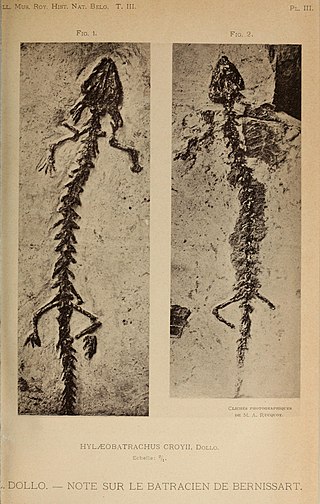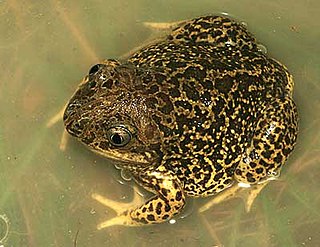
Pelobates fuscus is a species of toad in the family Pelobatidae, native to an area extending from Central Europe to Western Asia. It is commonly known as the common spadefoot, garlic toad, the common spadefoot toad and the European common spadefoot.

The National Museum of Natural Sciences is a natural history museum in Madrid, Spain. Dependent on the Ministry of Science, it is one of the National Museums of Spain, and it is managed by the Spanish National Research Council (CSIC).
Brachycormus is an extinct genus of salamandrid amphibian from the Oligocene–Miocene of Europe.
Aralobatrachus is an extinct genus of prehistoric amphibian known from Uzbekistan.
Apricosiren is an extinct genus of prehistoric salamander. It is known from the Berriasian aged Lulworth Formation in southern England.
Altanulia is an extinct genus of prehistoric amphibian.
Albionbatrachus is an extinct genus of prehistoric frogs from England and Romania. Two species are recognized: While previously synonymised with Palaeobatrachus, it is now considered a distinct palaeobatrachid genus based on characters of the frontoparietals.
Baurubatrachus is an extinct genus of prehistoric frogs found in the Maastrichtian Marília Formation of Brazil, formerly considered to be related to the extant family Ceratophryidae. However, a detailed assessment of the anatomy and relationships of the single known fossil of Baurubatrachus demonstrated that it is not part of Ceratophryidae and might be part of a much ancient group of Neobatrachia.
Baranophrys is an extinct genus of prehistoric amphibian of questionable taxonomic status. It is known from Villány, Hungary.
Eoxenopoides is an extinct genus of prehistoric frogs. It is known from Banke, a Maastrichtian/Selandian crater lake mudstone in South Africa.

Hylaeobatrachus is an extinct genus of prehistoric salamander, known from the Early Cretaceous of Europe. The type species H. croyii is known from the Sainte-Barbe Clays Formation at the Iguanodon locality of Belgium, and was described by Louis Dollo. An unnamed Hylaeobatrachus-like taxon has also been reported from Las Hoyas, Spain. Both localities are of Barremian age. Hylaeobatrachus belongs to the crown group of modern salamanders, though its exact relationship with modern salamander groups is uncertain. It was neotenic, llike some modern salamanders.
Hatzegobatrachus is an extinct genus of prehistoric toad. It is sometimes considered the earliest known member of the family Bombinatoridae. It is known from the Late Cretaceous Densuş-Ciula Formation and Sard Formation of Romania, in the region that was once Hateg Island.
Gobiates is an extinct genus of prehistoric amphibians. Fossils have been found in the Barun Goyot and Djadokhta Formations of Mongolia, the Bissekty Formation of Uzbekistan and the Paluxy and Twin Mountains Formations of Texas in the south-western United States. The following species are recognized:
Nezpercius is an extinct genus of prehistoric amphibian.

Neusibatrachus is an extinct genus of frog, known from the Early Cretaceous (Barremian) La Pedrera de Rúbies Formation of Spain. It is one of the oldest representatives of Pipimorpha.
Macropelobates is an extinct genus of prehistoric frogs. It was described by Gladwyn Kingsley Noble based on material from Oligocene of Mongolia.
Procynops is an extinct genus of prehistoric amphibian.

Palaeopleurodeles is an extinct genus of prehistoric amphibian.
Scotiophryne is an extinct genus of prehistoric amphibian.

Pelobates cultripes is a toad species in the family Pelobatidae. It is known under many different common names, including the western spadefoot, Iberian spadefoot toad, Spanish spadefoot toad, and Wagler's spadefoot toad. It is found in most of the Iberian Peninsula with isolated populations southern and western France.





